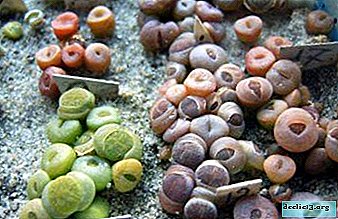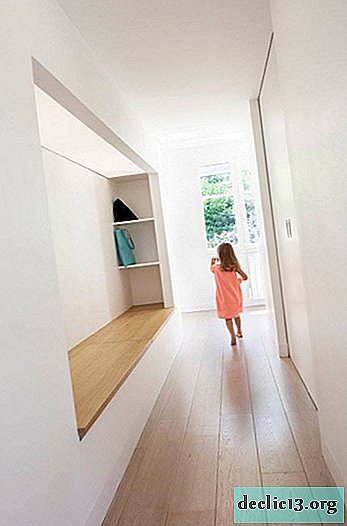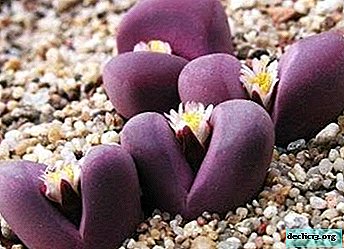How to grow lithops from seeds at home?

Lithops are original flowers belonging to the genus of succulent plants. In the people they are also called "living stones". They grow in the sandy deserts of the African continent. There are more than 40 varieties of lithops, but only 15 of them are suitable for breeding as a houseplant. Given the characteristics of this flower and following the rules, it can simply be grown in indoor conditions. The article describes how lithops breed by seeds and how to grow them correctly.
When to start growing "living stones"?
Vegetative propagation of lithops is possible, however, they are mainly grown from seeds. In order to grow healthy lithops, it is necessary to take into account the life cycle of the flower. It is directly related to the duration of daylight hours.
Reference. When grown in an apartment, the life cycle of a plant may shift slightly.The resting period of the plant lithops falls in the summerwhen the longest daylight hours. At home, drought occurs at this time. But at the end of August a flower wakes up and blooms. After flowering, the leaves begin to change. And only at the end of February the old leaves completely give way to young shoots. It is at this time that the sowing of young seeds is recommended.
Step-by-step instructions on how to grow at home
Germination of lithops seeds is a painstaking task. However, observing certain rules, a novice gardener can cope with it. The main thing is to properly prepare and take into account the characteristics of this plant. You can sow seeds from late autumn until late spring, but the beginning of March is considered the most favorable period.
Priming
First of all, it is necessary to prepare the soil. For sowing lithops, the usual peat soil will not work. It is necessary to prepare a special mixture that is most similar to the desert soil native to lithops. To prepare it, you need to take:
 1 part of crushed red brick (the size of the fragments should be about 2 mm);
1 part of crushed red brick (the size of the fragments should be about 2 mm);- 2 parts of turf land;
- 2 parts of sand;
- 1 part clay;
- 1 part peat.
Stir the components and bake in the oven, then cool and well loosened. At the bottom of the pot you need to pour drainage of fine gravel, about 25-30% of the height, then the prepared soil and moisten it well. After that, the soil is ready for planting seeds.
Recommendation. Adding ash to the soil mixture will prevent rotting.For growing lithops at home it is better to choose a pot that will not taper to the bottom. Well, if it's a wide bowl. The choice of such dishes will provide good ventilation and moisture permeability.
Landing
When choosing seeds, you need to know their age. Lithops seeds retain their germination for 10 years, but they best germinate in the third year of storage. How to plant and how to sprout their seeds?
- Before planting the seeds must be soaked. To do this, they are placed in a solution of manganese for 6 hours, but not more.
- How to plant? After that, they need to be distributed without drying over the surface of the soil. After they are planted, sprinkle with earth on top is not necessary.
- To create a comfortable environment, the sown seeds are covered with a film or glass. The container should be well lit, however, it should not be in the scorching sun.
From the video you will learn how to sow lithops at home:
First time care
For germination of seeds you need a certain microclimate. When creating it, it is necessary to focus on conditions in the natural habitat.
Temperature and lighting
Seeds germinate at a temperature of 10-20 degrees. In this case, it is desirable to create temperature differences at night and daytime. During the day you need to adhere to a temperature of 28-30, and at night 15-18. This will create conditions, approaching the habitat of lithops in nature.
Important! Lithops do not like heat in confined spaces. It is necessary to ensure the flow of air.If the seeds were planted in the summer, at the age of one month, you can leave them open or make the shelter spacious enough - at least 10 times the area in which they grow.
Lithops needs bright lighting all year round. If there is not enough light, the leaves will stretch and darken.
Air humidity
 Once or twice a day, you need to open the seeds, air them for 2-3 minutes and spray them with a spray bottle. It is important that the water droplets are not large, they must imitate the dew, otherwise the plant will die from rot. Lithops do not like waterlogging, watering the earth is not necessary. With this care, the seeds will germinate in 6-10 days.
Once or twice a day, you need to open the seeds, air them for 2-3 minutes and spray them with a spray bottle. It is important that the water droplets are not large, they must imitate the dew, otherwise the plant will die from rot. Lithops do not like waterlogging, watering the earth is not necessary. With this care, the seeds will germinate in 6-10 days.
After the seedlings have sprouted, the amount of airing can be increased up to 3-4 times a day, and the airing time can be extended to 20 minutes. Now you can not moisten the soil every day, you need to do this only as necessary. Moisten only if the soil surface is dry.
Transfer
After the seedlings sprout, the soil can be mulched with small pebbles. Firstly, it will provide support to young plants prone to lodging. Secondly, it will prevent the appearance of rot.
Dive seedlings only if they are close. However, experts recommend that you do not do this before the plant has wintered for the first time. In addition, even an adult lithops does not need frequent transplants. If the need for transplantation arose, it is better to do this during a period of active growth.
Recommendation. Lithops does not like to grow alone. It is advisable to plant them in a group of several or with other stunted succulent plants. It is proved that they grow much better this way.Watering and feeding
It is necessary to water an adult plant very carefully. It is better to pour water with a spoon into the soil near the seedlings or just put the pot for a while in a pan with water. The root system of the lithops is very developed and he himself will take nutrients from the soil. It is necessary to ensure that water does not fall into the hollow between the leaves - this can lead to decay of the plant. In the autumn-winter period, lithops do not need to be watered at all.
Lithops, like other succulents, is very hardy and does not need constant feeding. It may be needed only if the plant has not been transplanted into new soil for many years.
From the video you will learn about the features of lithops irrigation:
You can find out what permanent care lithops need from this article.
Photo
Next, you can familiarize yourself with the photo and see what lithops grown from seeds look like:





Can I plant in open ground?
In the period from May to September, lithops can be brought to fresh air. This will harden the seedlings and contribute to flowering. However, planting them in open ground is not worth it.
Reference. In winter, they can simply freeze, he does not like frequent transplants from the pot and back. In addition, rains can fall into the hollow between the leaves, which is harmful for the lithops.Why not growing?
For the proper development of the plant, you need to carefully monitor the soil moisture. Lithops hails from dry places and does not like stagnation of moisture, so abundant watering is contraindicated. Sometimes it can be wiped with a damp cloth, but water should not remain on the surface of the plant.
Often precisely violation of the watering regime causes the small lithops to stop growing. If, however, the soil was waterlogged, it is necessary to completely stop watering and wait until the soil is completely dry.
Also, the cause of growth retardation can be a disease. Lithops are quite resistant to disease, especially in hot weather. However, as the temperature decreases, they become more susceptible. The most common pests for lithops are:
- Aphid. She sucks the juice from the leaves. In the initial stages, an infusion of hot pepper or garlic will help to fight it, if more serious measures are needed, you can use insecticides (Actellik or Aktara).
- Spider mite. When white plaque appears, the plant should be treated with Actellik's solution. Treat every 5-7 days.
- Mealybug. If the disease is noticed in the early stages, you can wash the plant with soap and water. In a more advanced case, treatment with Actara or Phosphamide will help. Treat once a week.
- Root rot. To combat it, you need to dig a plant, inspect the roots and remove areas damaged by the disease. Treated plant roots are immersed in a 2% solution of Bordeaux fluid for half an hour, after which lithops can be planted in new soil.
Lithops are amazing plants, striking in their appearance. They are quite unpretentious in leaving, however, under the created comfortable conditions they can grow into a whole colony that can please with bright flowering.

 1 part of crushed red brick (the size of the fragments should be about 2 mm);
1 part of crushed red brick (the size of the fragments should be about 2 mm);















